






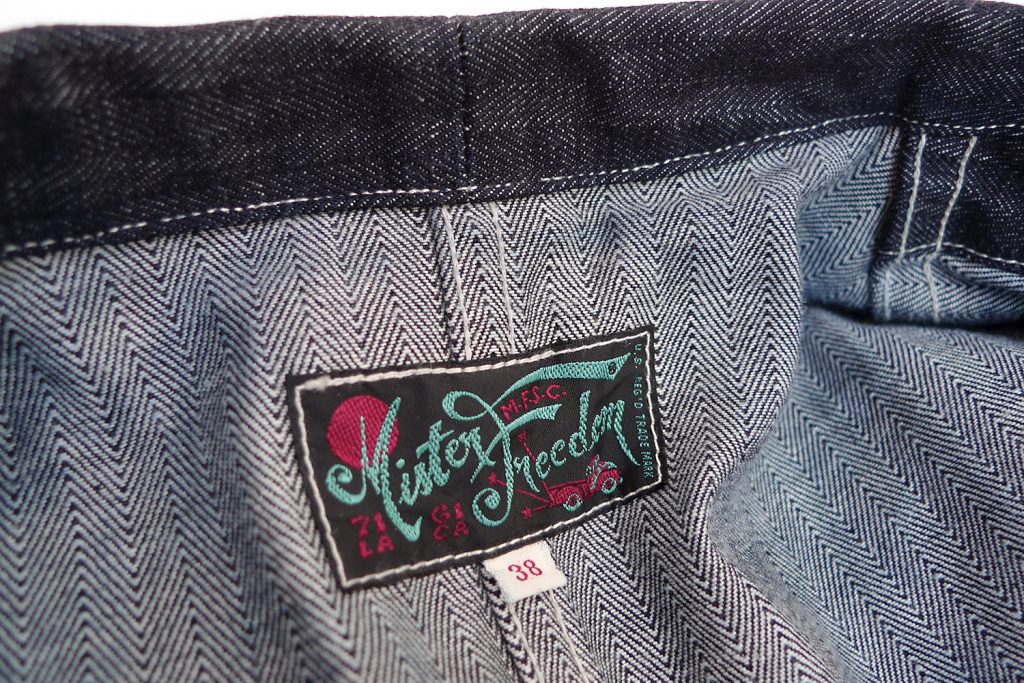
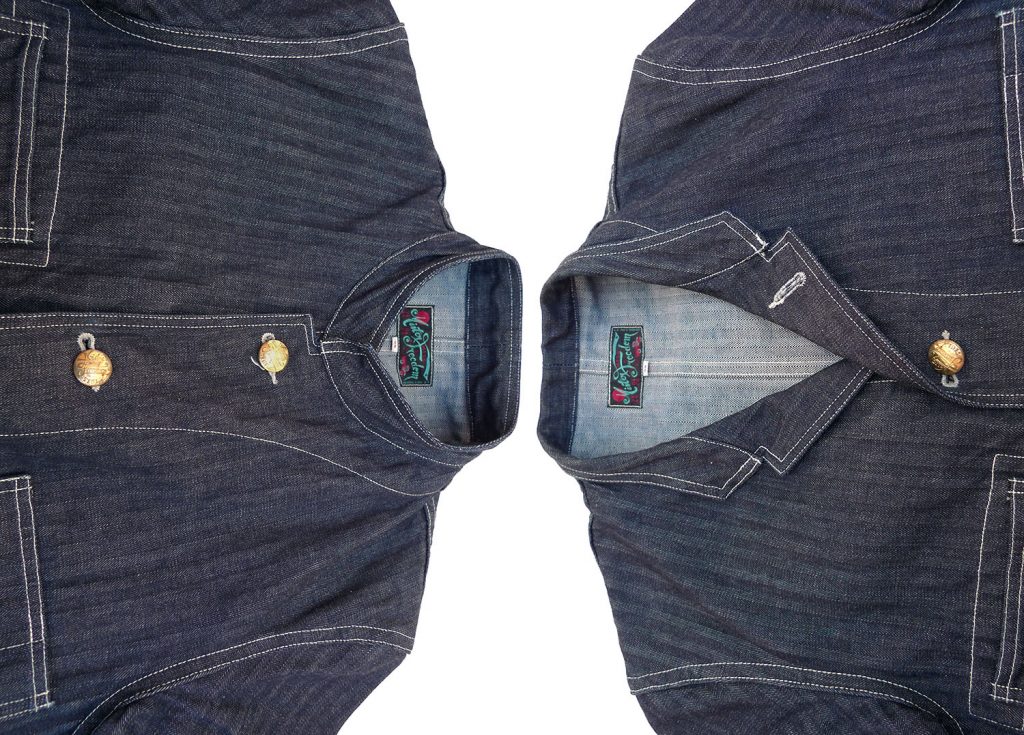



Mister Freedom® “McKARSTEN” Jacket, indigo métis & HBT denim.
SS2019 mfsc SURPLUS catalog.
Made in Japan.
The latest “might-have-been” we are adding to the Mister Freedom® x Sugar Cane Co mfsc Surplus catalog – our on-going collection of made-in Japan classics á la MF® – is the “McKARSTEN” jacket. The moniker is a reference to our beloved Peter Karsten, and workwear label Lakin & McKey‘s early days (founded in 1908, known today as Key Apparel.)
Our original pattern morphs several ill-fitting period garments into one wearable and contemporary piece with a vintage turn-of-the-century Old World vibe. The body of the McKarsten was inspired by a 1940’s medical field work cotton jacket made by “Nostrand Uniform Co“. The pockets were lifted from a 1930’s “TEST” chin-strap railroad jacket, aka chore coat or engineer jacket. The McKarsten features front panels with rounded bottom, cut longer than the split-back panel, and four patch pockets.
 Vintage inspiration of the SS2019 Mister Freedom® McKarsten jacket. This hybrid garment mixes utilitarian early workwear and old-fashion uniform tailoring. The removable “ring” buttons (or shank buttons) are characteristic of 1920’s-30’s uniforms, but also denim railroad jacket styles, much sought-after by vintage hunters today.
We had our version of these shank buttons custom-manufactured by our friends at Sugar Cane Co, using an obsolete pattern registered in 1913, featuring an octogonal-shaped back and a brass shell cap with original MF® branding. Removable buttons, often found on wool military tunics and work uniforms, were un-clipped and detached when the garment required cleaning. For military inspection, the metal buttons could be polished separately.
Besides the complicated construction of the garment button placket itself (look behind that attractive curved single stitch line around the collar, on the button eyelet hole side), the requirement of an eyelet-stitch machine for the manufacturer, buttons or rings would at times get lost. This fastening system proved quite impractical over time and was mostly abandoned by the 1950’s. Shank “ring” buttons are today a telltale of a desirable piece of costume history for the vintage clothing aficionado.
For the DIY-inclined, one can be creative, play around with colors and spray-paint our MF® brass buttons. Soaking them overnight in vinegar might hasten aging, but, with a bit of patience and wear, the brass buttons will naturally acquire an attractive patina overtime.
 Examples of DIY spray-painted original Mister Freedom® “ring” buttons for the McKarsten jacket ©2019 
The stand-collar or “cadet collar” pattern allows buttoning the McKarsten all the way up, for the “James Bond villain” meets Jawaharlal Nehru look. For a more relaxed demeanor, the collar can be folded into traditional coat lapels, with a high-button front jacket look.
We are realizing the McKARSTEN in two distinctive fabrics. One is a 10 Oz. HBT indigo denim. This fabric is what happens if you mill traditional indigo-dyed warp yarns and natural color weft yarns, into a woven herringbone twill pattern.
The second fabric option is a 7 Oz. blend of 75% linen and 25% cotton (referred to as métis in French), plain weave, indigo and black yarns, selvedge. This fabric was inspired by a 1920’s pair of French work pants, and milled with similar specs. Our version is very “breathy” and not tightly-woven, making it a great summer-weight fabric, with a somewhat see-through quality not uncommon on vintage tropical garb. The fabric drape and dry hand is typical of high-content linen métis.
The mfsc “McKARSTEN” jacket is designed in California by Mister Freedom® and manufactured in Japan by Sugar Cane Co.
FABRIC:
Two distinct fabric options:
a) A sturdy 10 Oz. HBT dark indigo denim, 100% cotton, milled in Japan. (Option featuring contrast stitching.)
b) An elegant 7 Oz. plain weave dark indigo métis, blend of 75% linen and 25% cotton, indigo warp and black weft yarns, solid white selvedge ID, milled in Japan. (Option featuring tonal stitching.)
SPECS:
* An original MF® pattern inspired by vintage early denim work chore coats (aka engineer jackets), early work uniform cotton jackets, and Old World tailoring.
* Stand-collar (“cadet collar”) type, foldable into traditional coat lapels, for a high-button jacket look.
* Removable “ring” (shank) buttons, secured by a metal ring through an eyelet.
* Original MF®-branded brass buttons, 1920’s style.
* Concealed indigo poplin facing for patch pockets, and for button eyelets panel placket.
* Four front patch pockets, featuring a traditional railroad jacket “pocket watch” compartment and pen slot combo.
* Uniform-style form-fitting rear panel pattern.
* Early tailoring style off-set shoulder yoke.
* Contrast stitching for the HBT denim option, tonal stitching for the indigo métis.
* Original mfsc SURPLUS woven label.
* Made in Japan.
SIZING/FIT:
Both options come raw/unwashed.
We recommend the usual initial 30mn cold soak/occasional hand agitation/spin dry/hang dry process. The tagged size reflects the size of the garment after going through this process. The subtle variation of shrinkage between body fabric/indigo poplin facing/cotton thread will result in puckering and roping, slightly altering the fit and drape.
The indigo métis version appears to be cut more generously than the HBT denim option, due to the lighter-weight fabric and totally different drape. Additionally, the métis loosely-woven fabric tends to naturally stretch back after the initial shrinkage.
I personally opted for a Size 38 in the HBT denim version, my usual size in mfsc jackets. The fit is quite comfortable, giving room for further potential shrinkage, when the garment will have to be fully laundered, and to minimal layering.
I went for a Size 36 in the indigo métis, as the 38 felt too roomy for my preference, especially after the mechanical stretch following a bit of wear. The arm opening of the 36 is snug but not uncomfortable when worn with a light shirt underneath.
When considering the length of the McKarsten, please note that the front panels are cut longer than the back panel, a characteristic of this early workwear jacket pattern.
Please refer to chart for approximate raw/soaked measurements. This explains how we size our garments.
Soaked = 30mn cold soak, spin dry and line dry.
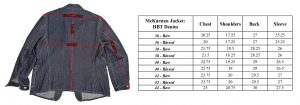 McKarsten HBT Denim  McKarsten Indigo Metis CARE:
We recommend removing the front brass buttons before cleaning (not the tack buttons of the sleeves!), to avoid potential snagging. When needed, machine wash the MF® McKARSTEN on DELICATE, cold water, mild eco-friendly detergent. Hang dry.
Wash separately to avoid color transfer to light-color garments. Turn the McKARSTEN jacket inside-out to avoid potential marbling of the indigo fabric.
Full wash cycle and heat dryer are not recommended and could damage the garment.
Sizes:
Small (36)
Medium (38)
Large (40)
X-Large (42)
XX-Large (44)
Available from www.misterfreedom.com, our Los Angeles brick & mortar store, and fine retailers around the World.
Email [email protected] or call 323-653-2014 with any questions unanswered above.
Thank you for your support.
Christophe Loiron
Mister Freedom®
©2019






 
 




Mister Freedom® “Veste BELLEVILLE” & “Pantalon CAMARGUAIS”, mocha HBT linen/cotton.
FW2018 “Surplus” mfsc collection.
Made in Japan.
We are adding a French twist to the MF® “Surplus” mfsc catalog this season, in the form of two vintage-inspired design classics lifted from the Old World.
The top piece, a classic pattern we reinterpreted and chose to call Veste Belleville, is a style familiar to most today, as it has made it into international streetwear for years. Many modern fashionable versions exist. It is mostly known as the French work jacket, and often referred to as ‘bleu de travail’ (work blues) in its homeland. Our interpretation features the typical two-piece spliced collar, a staple of these French workwear chore coats.
Our Veste Belleville was introduced during the swinging days of our Gypsy Blues escapade, and issued at the time in a covert woven stripe twill, and in a foxy indigo-dyed HBT linen/cotton blend version. That herringbone twill was inspired by vintage French firemen uniforms of the 1900’s. The few rare antique specimen that have survived today are sought-after treasures for designers and militaria collectors alike, both the indigo and black/dark brown versions.
Below, our friend Jérome Girard, aka “J” or “Le Zouave”, fiercely models a 1900’s French Fireman tunic, an authentic early model with an impressive indigo patina. The ‘Nam boonie hat is a nice touch. Photo stolen from J’s epic IG feed.
What a mug, what a legend! Magnifique!

In its un-dyed, loomstate form, our 80% linen-20% cotton blend HBT fabric comes in a natural un-bleached ivory color. It has been featured loomstate on the MF® Waterfront Coat released in 2016.
This season, we decided to offer the same textile in a rich and warm dark brown “mocha” color. Because of the specific method of fabric-dyeing we opted for, the core of the yarn keeps its original off-white color, a telltale of future attractive patina.
Now the pants. The bottom piece is also a classic European garment pattern we reinterpreted, a traditional 1900’s-1930’s style of French work pants popular with farmers and laborers. We decided to name this pattern “Pantalon Camarguais” because of the twist we put on it.
Pronounced KA-MAR-GAY (the u is silent), the adjective is a reference to a French region called Camargue. For those unfamiliar with this beautiful corner of the world, we mentioned it briefly while introducing the Gilet Gadjo of the 2017 Gypsy Blues collection.
“ … If black and navy blue are typical colors of old-school French workwear, brown and cream moleskin garments were quite popular with the Gardians of Camargue, the gritty Provençal cowboys dreamed-up by the legendary Old-West-obsessed Folco de Baroncelli in the early 1900’s. In the old days, these famed horsemen of the delta of the Rhone, Southern France, typically wore moleskine boot-cut riding pants, with the characteristic contrast piping running down the leg seam. A matching moleskin vest, flamboyant plaid or printed cotton shirt, low-crown western-style hat, and a pair of Camarguaises (local traditional rough-out leather boots) often completed these work outfits.
(For the commun thread between Gardians and our Gypsy Blues story, Camargue’s most iconic commune is Saintes-Marie-de-la-Mer, a notorious annual pilgrimage destination for Gypsies coming from the four corners of Europe.) “
The Provence cowboy connoisseur will note that our “Camarguais” pattern is a blend of vintage style references, but absolutely not a replica of the typical French Gardians’ riding trousers mentioned above. As admirative and respectful of Costume History as we are, we took some liberties with authenticity on this one. One of our inspirational piece for the project, the vintage super-high-waisted blue moleskine pantalon pictured below, was re-worked into a 21rst Century wearable, sans the charming albeit ill-fitting and costumey vibe of the original. The back rise reaching the shoulder blades is a bit hard to pull-off these days.

The pocketing we opted for, for both jacket and pants, will look familiar to the ol’ MF® OG: it was featured ages ago on our Pantalon Ouvrier. This sturdy indigo stripe ticking fabric was also inspired by antique French textiles.
Voila!
Pair these fine pieces as a set and call it le French leisure suit, or incorporate either for a touch of rugged Old World elegance in your wardrobe, the Veste Belleville and Pantalon Camarguais are now part of the Mister Freedom® SURPLUS collection of international classics, made for the discerning Gentleman of style concerned with ethical manufacturing.
The MF® “Veste BELLEVILLE” & “Pantalon CAMARGUAIS” are designed in California by Mister Freedom® and manufactured in Japan by Sugar Cane Co and the expert Toyo Enterprise team.
SPECS:
FABRIC:
A fancy 15 Oz. blend of 80% linen and 20% cotton Herringbone Twill (HBT), dyed in small batches in a warm mocha brown color, keeping the core of the yarn natural. Selvedge fabric, expertly milled and dyed in Japan.
Lining and pocketing: 8 oz. indigo/white warp and black weft striped twill, fine herringbone weave, white selvedge, un-sanforized (respectfully lifted from a late 1800′s swatch of french workwear textile)
1) MF® Veste BELLEVILLE, mocha HBT.
DETAILS:
* Inspired by classic 1930’s-40’s traditional French work/farmer jackets.
* Utilitarian unmarked ‘donut’ brass metal buttons.
* Three outside patch pockets. Elongated chest pocket fits some iPhone models.
* Concealed chest pocket, featuring the MF® “SURPLUS” woven label.
* Contrast indigo stripe ticking button placket facing.
* Early tailoring off-set shoulder seam pattern.
* Arms mounted with piping method, indigo-dyed tape.
* Flat-felled seam construction, hi-count tonal stitching.
* Made in Japan.
SIZING/FIT:
The MF® Veste BELLEVILLE, mocha HBT comes raw/unwashed, and will shrink to tagged size.
Follow the usual recommended initial method before wearing: cold soak for 30mn, occasional hand agitation, spin dry and line dry.
We recommend sizing down on MF® Veste BELLEVILLE in mocha HBT, as we had advised for both the indigo and covert original versions. I usually wear 38 (Medium) in mfsc jackets, but went with a 36 (small) with the Belleville, without arm-hole issues.
Please refer to chart to figure which size works for you. If still confused, email [email protected]

Available raw/unwashed.
Sizes
36 Small
38 Medium
40 Large
42 X-Large
44 XX-Large
1) MF® Pantalon CAMARGUAIS, mocha HBT.
DETAILS:
* An original mfsc pattern inspired by vintage French farmer/laborer work pants and 1900’s European trousers.
* Cinch-back with vintage-style steel/copper combo sharp prong buckle.
* “French seam” style outseam, featuring the HBT fabric selvedge ID.
* Early French trousers style back yoke.
* Rear expansion gusset featuring the indigo ticking pocketing fabric ID selvedge.
* Slim beltloops.
* Utilitarian unmarked ‘donut’ brass metal buttons.
* Arcuate stitch design on pocket openings.
* Rear gusset featuring the indigo ticking pocketing fabric ID selvedge.
* Art Deco-style sheet metal suspender buttons.
* Flat-felled seam construction, hi-count tonal stitching.
* Made in Japan.
SIZING/FIT:
The MF® Pantalon Camarguais, mocha HBT comes raw/unwashed, and will shrink to tagged size.
Follow the usual recommended initial method before wearing: cold soak for 30mn, occasional hand agitation, spin dry and line dry.
These trousers feature a quite generous cut. I opted to size down to a Waist 30, for a slimmer silhouette.
Please refer to chart to figure which size works for you.

Available raw/unwashed.
Sizes
W28 x L36
W30 x L36
W32 x L36
W34 x L36
W36 x L38
W38 x L38
CARE:
Hand wash or machine wash on delicate, cold water, minimal eco-friendly detergent. Turn inside-out to avoid marbling of the fabric. Line dry ONLY.
This fabric will develop attractive patina overtime, according to the owner’s activities, frequency of wear and laundering choices.
Available from www.misterfreedom.com, our Los Angeles HQ, and fine retailers around the World.
Email [email protected] or call 323-653-2014 with any questions unanswered above.
Thank you for your support.
Christophe Loiron
Mister Freedom®
©2018












Veste Belleville, indigo cotton/linen HBT & cotton covert stripe.
“Gypsy Blues” mfsc collection Spring 2017
Made in Japan
Recently unveiled in the “Gypsy Blues” mfsc Spring 2017 Lookbook, our latest seasonal venture in vintage-inspired menswear features a 78rpm “Jazz à Cordes” soundtrack… Unless you said “a who?”, you can skip this intro and scroll down to the SPECS to get straight down to bin’ness…
Pioneered by future members of the Quintette du Hot Club de France in the 1930’s, a novel musical style known today as “Jazz Manouche” (“Gypsy Jazz”, “Gypsy Swing”,…), made its way from the Boite à Matelots (Cannes, circa 1931), to guinguettes on the Seine river, bal musettes, and smokey jazz caves of hopping Saint-Germain-des-Prés (Paris, 1950’s). This new musical genre, a type of continental jazz originally consisting of string (corde) instruments (as opposed to brass instruments) soulfully improvising on traditional hot jazz standards and chansons in a specific style, stayed quite popular in France for a few decades, eventually crossing borders and oceans, anecdotally making an appearance in Hollywood in a Woody Allen film in 1999.
The QHCF, ‘house band’ of the Hot Club De France, was driven by the creative genius of Django Reinhardt, a young Manouche (French Gypsy) guitar player born in Belgium, settled down in France. With a left hand notoriously crippled in a caravan fire when he was 18, Django literally invented a unique guitar style, sound and technique that still puzzles and humbles guitarists today. His expertly-crafted solos are always so unique, so adventurous yet melodic, that each bar becomes a melody within a melody, each improvisation a standard within a standard. Many of his compositions, such as the ultra-famous Nuage or Minor Swing, are forever associated with his own original recorded renditions and have become anthems for Gypsy Jazz musicians over the years.
I recall my Dad not having much positive things to say about Rock & Roll or Yéyé pop tunes… The family’s selection of LP’s and 45’s at home clearly showed his preference for traditional Jazz. A big fan of Django Reinhardt early on, he liked to recount having purchased tickets to go see the Hot Club perform live in Bordeaux, France, in the summer of 1953. On May 16th that year, a few months before the event, Django passed away…
Many years later, when visiting Paris in the 1980’s, my Father used to take us kids to “La Chope Des Puces”, a then-unassuming café near the Puces de St Ouen (famous Parisian flea market). I remember us sipping expressos at the counter, to the sounds of Daphné, Tes Yeux Noirs or Ménilmontant, performed by a Manouche duet (they might have been Mondine & Ninine Garcia), jamming on beat-up Maccaferri-type guitars with jerry-rigged Stimer pick-ups. That place still exists today, having become quite the tourist attraction with a full-blown restaurant.
 La Chope Des Puces with Mondine & Ninine Garcia, 1960’s (Photo credit Ginette Douville) Today, Django Reinhardt’s known body of work is well-documented and easily available on well-curated and exhaustive CD collections. On-line forums dissect his career and recordings, passionately discussing Django’s style, guitars and whereabouts during the 43 years he blessed us with his earthly presence.
His musical legacy is also well alive in 2017, with amazing talents such as the Rosenberg Trio and many others, keen on keeping Django’s ears ringing, and la pompe (the specific strumming of the rhythm guitar that replaces the drums, trademark of Jazz Manouche) pumping.
If not yet familiar with this particular music style, treat yourself to some of Mr. Reinhardt’s six-string escapades on numbers like the endlessly melodious I’ll See You in My Dreams (1939), the frantic Belleville (1942), or electrified powerhouse Blues en Mineur (1947), …, just for a taste of that goodness. You won’t even need to like Jazz to appreciate. For visuals, watch Django’s effortless virtuosity on J’attendrai (1939), one of the very few surviving filmed clip that features synched sound/image. The apparently-lost movie “Clair De Lune”, filmed in 1932 by Henri Diamant-Berger, and boasting a soundtrack recorded live-on-set by Django himself, will hopefully surface one day and reveal more of the man in action…
 Django, on set of “Clair de Lune” (1932) Photo courtesy Teddy Dupont Django Station Messieurs Dames, after this typically rambling overture…showtime!
It is with that inspiring musical score in mind that we improvised a Mister Freedom® wardrobe for our mfsc “Gypsy Blues” story. For Spring 2017, we’ll be mixing 1930’s ~ 50’s French workwear and vintage European menswear, giving somewhat of a Sinti bohemian vibe to the collection.
We’ll kick our jam with a garment pattern familiar to most today, as it has made it into streetwear for several years now, and many modern fashionable versions exist: the French work jacket, known as ‘bleu de travail’ in its homeland.
Our Mister Freedom® jazzed-up interpretation of this classic, inspired by vintage 1930’s moleskine and twill specimen, comes in two distinct fabric options.
First is an indigo-dyed cotton/linen HBT (the same sturdy fabric of our Waterfront Coat, indigo-dyed to a dark and rich hue), a textile inspired by early French firemen uniform of the 1900’s. The second option is a 100% cotton stripe covert fabric, a sort of heather charcoal grey salt & pepper with a subtle woven stripe pattern, developed from a vintage swatch of 1930’s French workwear NOS textile. Both are milled in Japan exclusively for us, as-in not picked from a textile trade show.
The Veste Belleville is designed in California by MISTER FREEDOM® and manufactured in Japan by SUGAR CANE Co.
NOTE: Please note that the photos feature an indigo HBT Belleville worn for about a week, with hardware treated with antiquing solution (DIY salt water/vinegar should also work). Production comes with brass/copper buttons without patina.
SPECS:
FABRICS:
Option A
A sturdy 15 Oz. blend of 80% linen and 20% cotton indigo-dyed HBT textile, selvedge, milled in Japan.
Please note that some light streaking can be observed on some garment panels at times. This is due to the nature of indigo-dyeing this specific heavy textured fabric. This is not considered as a defect, and will subside with wear. This indigo-dyed fabric is very light sensitive and its hue will evolve rapidly.
Option B
A lighter 9 Oz. covert woven stripe 100% cotton fabric, milled in Japan.
DETAILS:
* Inspired by classic 1930’s French work/farmer jackets.
* Utilitarian unmarked ‘donut’ metal buttons (copper for the indigo, brass for the covert)
* Three outside patch pockets (chest pocket fits iPhone, we’re hi-tek like that).
* Indigo Wabash twill concealed chest pocket, featuring the MF® woven label.
* Indigo-dyed poplin button & button hole placket facing.
* Vintage off-set shoulder seam pattern.
* Arms mounted with piping method, indigo-dyed tape.
* Flat-felled seam construction.
* Made in Japan.
SIZING/FIT:
Both fabric options come raw/unwashed.
Follow the usual method, initial cold soak, spin dry and line dry.
We recommend sizing down on both the indigo HBT and the grey covert. I usually wear 38 (Medium) in mfsc jackets, but went with a 36 (small) with the Belleville, without arm-hole issues.
Please refer to chart to figure which size works for you. If still confused, email [email protected]
 
 
CARE:
Indigo HBT: When needed, hand wash or machine wash on delicate, cold water, minimal eco-friendly detergent. Turn inside-out to avoid marbling of the fabric. Line dry ONLY.
DO NOT use heat dryer as this will leave marbling lines and set un-natural creases to the indigo HBT linen fabric.
Covert stripe: Machine wash on delicate, cold water, minimal eco-friendly detergent. Line dry.
Available raw/unwashed.
Sizes
36 Small
38 Medium
40 Large
42 X-Large
44 XX-Large
Retail:
Indigo HBT: $549.95
Covert Stripe: $499.95
Available from www.misterfreedom.com, our Los Angeles brick & mortar store, and fine retailers around the World.
Email [email protected] or call 323-653-2014 with any questions unanswered above.
Thank you for your support.
Christophe Loiron
Mister Freedom®
©2017

Mister Freedom® x Sugar Cane MFSC Spring 2012 “Men of the Frontier“: Gunslinger Denim Jumper, Indigo twill & Desert twill
Here is our seventh and final installment of this season journey, the denim “GUNSLINGER JUMPER”.
Borrowing again from both the American West and the Old World, we have put together elements of work-wear jackets, early sack coats and forgotten silhouettes.
This design borrows from our MF® Bourgeron Biribi we have been making in-house in very limited runs, using 1920’s~30’s new-old-stock textiles. We haven’t specifically documented those, so there are no photos of all the rare fabrics we have used. But locals who visit the store might see some ‘specimens’ on our racks, before they get snagged by design teams for inspiration…
For the MFSC production of the Gunslinger Jumper, we had two different denim twill exclusively woven in Japan, both inspired by vintage swatches from our archives. One indigo denim with indigo back, and one white back unbleached natural denim. Both were milled in limited quantities. Those fabrics are the same we used this season for the Gunslinger Pantaloons.
They are also made in Sunny California, our beautiful State.
Hat courtesy of our friends Nico and Gregory at WESTBROOK MAKER , talented purveyors of head accoutrements and fine sombreros from Venice, California.
SPECS:
PATTERN: An original MF® pattern, inspired by both the New and the Old World, mixing elements from European work wear and early American unlined cotton coats. Sack coat meets work coat.
FABRIC: The Gunslinger Jumper comes in two very different fabric options (not two colors of the same fabric.)
Exclusively milled for us in Japan, in limited batches.
a) MFSC Indigo denim twill: Dark Indigo warp x dark Indigo weft, 100% selvedge Cotton, 12.4 Oz., Solid white selvedge ID. A very rich dark indigo color, with purple hues, in and out.
b) MFSC Desert denim twill: Natural warp x White weft, 100% selvedge Cotton, 12.8 Oz., Solid white selvedge ID. This is not your typical off white twill. This fabric has a lot of texture, character, ring and slub.
DETAILS:
* Selvedged button placket facing, lower pocket hem and cuff facing.
* Round “A-1” type collar.
* Inner chest concealed pocket.
* Gun metal color donut button front.
* Cinch back strap. NOS metal sharp prong buckle (we have sadly run out of our stock of these, so this is one of the last time we use them for production)
* Flat felled seam construction with tonal 100% cotton thread.
* MFSC woven rayon labeling concealed inside left front patch pocket.
* Our trademark “Z stitch” sizing sail cloth patch.
PACKAGING: For the USA, the Jumper comes in an old school cardboard box with original MF artwork. This sturdy box can be used for storage of small items, please re-use.
SHRINKAGE/SIZING:
Both denim options come RAW (un-washed). Both fabrics are un-sanforized and will shrink down to the same fit after several wash/soak/dry cycles. The Jumper will shrink to the tagged size.
The Desert denim (natural) shrinks ‘faster’ than the Indigo denim. I recommend doing an original cold soak and hung dry. See how it fits and take it from there. With rinsing/wearing, the fabrics will shrink/stretch back and forth for a while and settle eventually.
Do not just wash your indigo gunslinger jumper in hope of getting instant patina, wear it instead.
DISCLAIMER: Because of the nature of the double indigo dyed yarn, bleeding is expected with the INDIGO denim twill, on BOTH sides of the fabric. You WILL get some color rubbing on other garments and body. The bleeding stops overtime after normal wear/wash, and overtime, your jumper will get an amazing patina inside AND out.
See sizing chart below for raw and rinsed measurements (garments were cold soaked for about 20mn, no agitation, spin cycle then line dried)

Garment designed and manufactured in California by Mister Freedom® in collaboration with Sugar Cane Co (MFSC).
Available RAW/Unwashed
Sizes: 34, 36, 38, 40, 42, 44
Retail: $439.95
Call the HQ at (323) 653-2014 or mail [email protected] to get yours while they last. We ship almost everywhere internationally. Thank you mucho for your support 😉
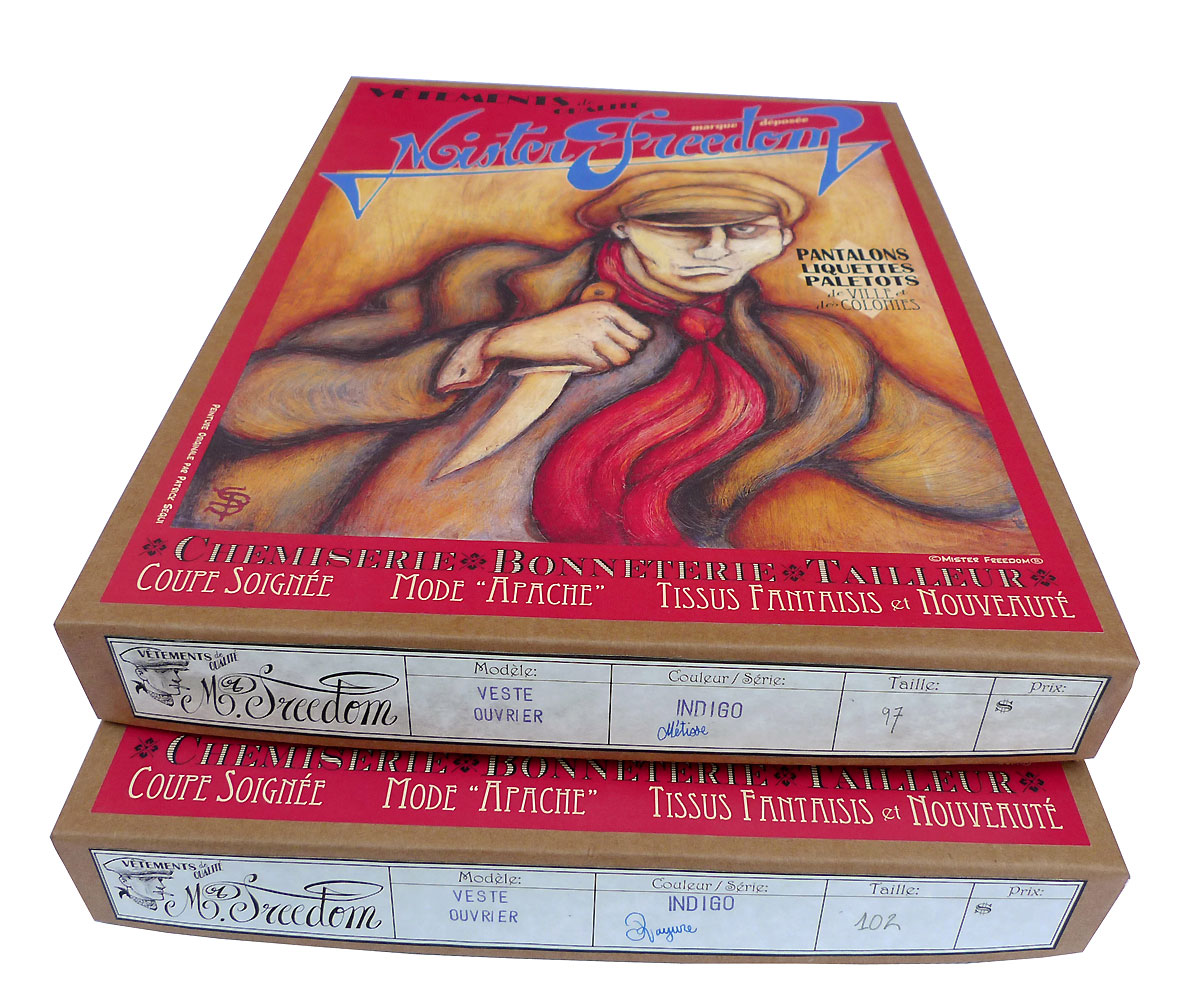
 
 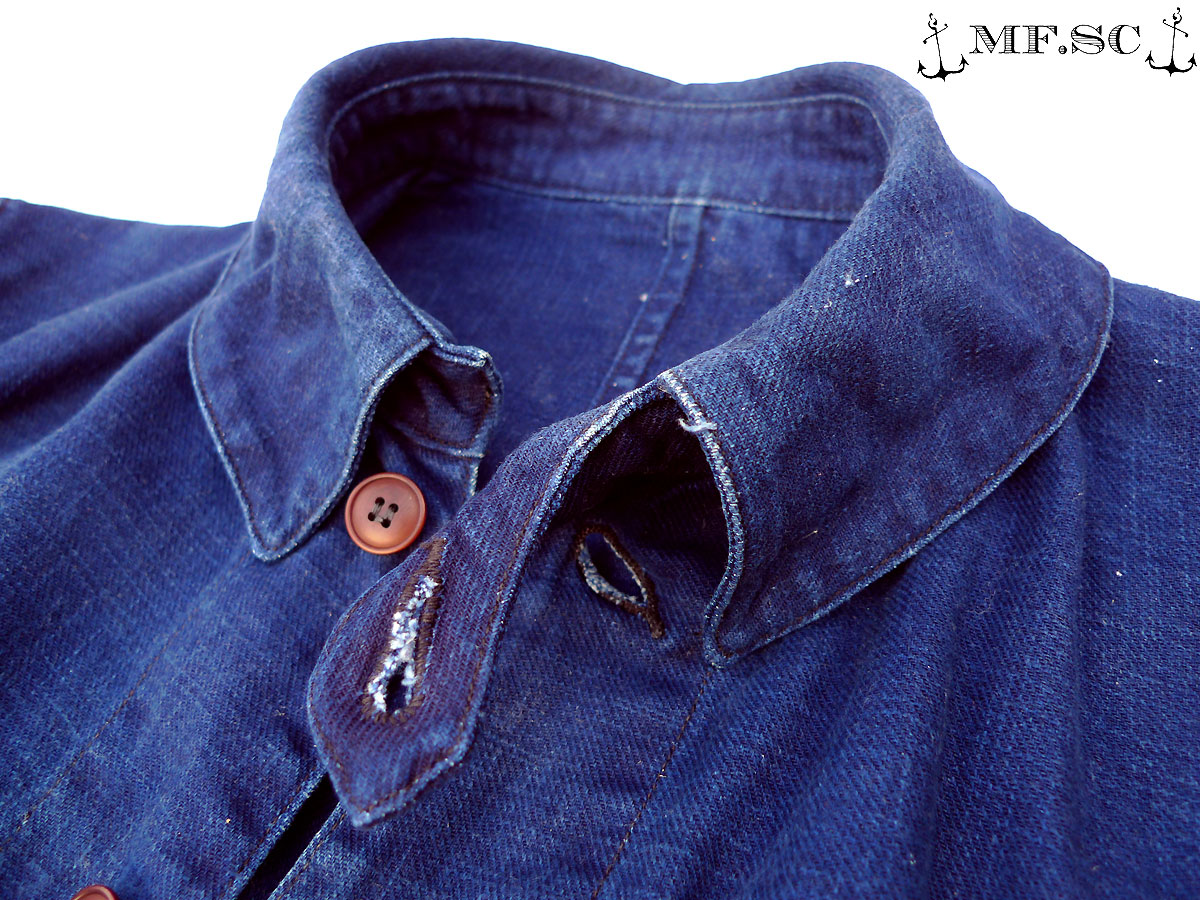
 
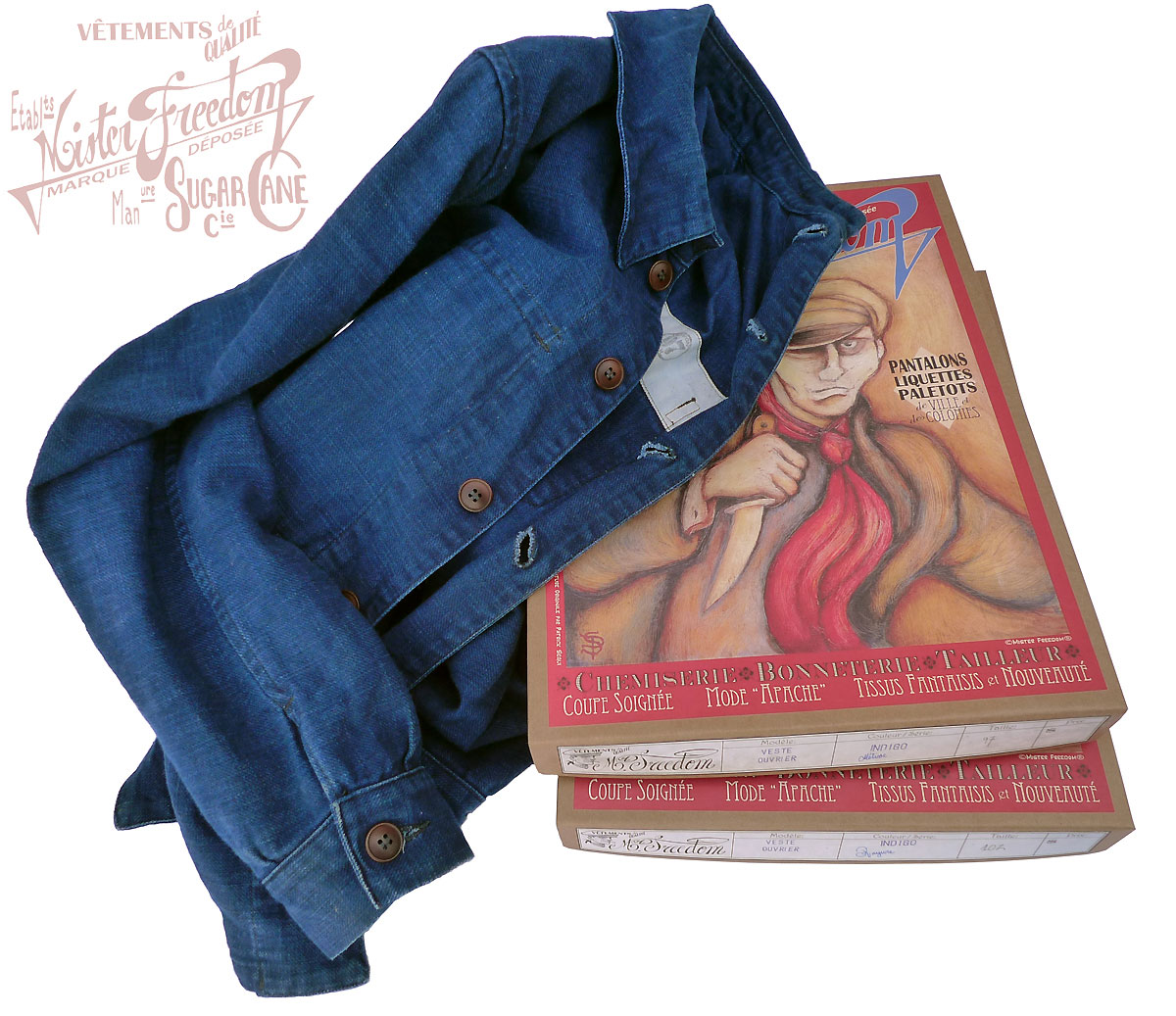
MISTER FREEDOM® x SUGAR CANE Spring 2011 Collection “Les Apaches”: VESTE OUVRIER
Voila l’été…et voila les Apaches!
I would like to thank everyone involved in making this collection a reality, all the believers, supporters, risk takers and hard workers, especially our friends at Sugar Cane Co for their unconditional support with this new MFSC collaboration.
MFSC Veste Ouvrier (workman’s jacket):
Inspired by early french work wear gear, the first installment of the MFSC Apache collection is a our version of a french worker’s coat. We combined elements of several 1900’s to 1940’s pieces to make our veste ouvrier. We kinda like that one…
SPECS:
PATTERN: An original MFSC pattern and fit, inspired by early french bleu de chauffe.
FABRIC: Two options (fabrics loomed in Japan exclusively for MFSC):
A) INDIGO Métisse: 9.7 oz. indigo dyed twill blend, 70% cotton and 30% linen, un-sanforized. The yarn core is white, the indigo outer has a purple blue shade typical of early french indigo work clothes. Fades, bleeds and reacts to sun light…
B) INDIGO Rayure: 8 oz. indigo/white warp and black weft striped twill, herringbone weave, white selvedge, un-sanforized (respectfully lifted from a late 1800’s swatch of french textile). Fades…
BUTTONS: Original MFSC Corozo natural wood buttons. (aka “vegetable ivory”, corozo buttons where an hi-end option for suiting from the 1900’s to 1940’s). Five button-front.
DETAILS:
* Original slanted button holes, to keep straight vertical closure.
* Inside white cotton twill pocket backing, to reinforce pocket top edges.
* Concealed chest pocket, with flap covering the MFSC woven label (NO visible branding/logo, so you don’t feel like a billboard…).
* Cinch back belt, with original french NOS metal sharp-prong buckle (DISCLAIMER: guaranteed to mess up your car seat, but we figured they have been around on battle fileds and in factories since the 1840’s, so we’re taking the risk in 2011…). The buckle is removable and you can switch to one that fits your needs.
* Concealed chin strap.
CONSTRUCTION: Tailor type single needle french seams, no overlock nor chainstitch. 100% Cotton thread, oxidized black/brown colour.
SHRINKAGE: Both fabric options are RAW and unwashed, and will shrink lightly with cold wash/hang dry.
SIZING: The Apache collection is sized/labelled in french! (all the way, baby…).
92 (small), 97 (medium), 102 (large), 107(Xlarge), 112(XXlarge)
PACKAGING: The garment comes in an individual old school chipboard box, exclusive to MF.
The original oil painting was masterfully executed by Mr. PATRICK SEGUI of RIVETED blog fame, and a paper print of his artwork will be featured on the Apache Collection box tops. Merci M’sieur Pat’…☺
LIMITED EDITION: For US and EU, a total of 130 jackets were made
A) 70 pieces of INDIGO Métisse veste Ouvrier
B) 60 pieces of INDIGO Rayure veste Ouvrier
Garment designed in California by MISTER FREEDOM® and manufactured in Japan by Sugar Cane Co.
Available RAW (unwashed)
Sizes S, M, L, XL, XXL
Indigo Métisse (solid): Retail $579.95
Indigo Rayure (stripe): Retail $549.95
NOTE:
The Indigo métisse veste ouvrier featured in the above photos has been worn ‘in the field’ on/off for about 2 months, washed cold about 5 times, minimal soap, hang dry. NFS. Production jackets are NOT distressed and are available UNWASHED only.
Call John or Jordan at (323) 653-2014 or mail [email protected] or [email protected] to get yours while they last. We ship internationally.
|



































































































